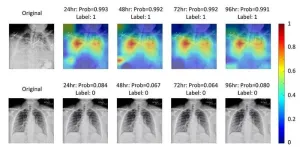(Press-News.org) Markers that indicate the presence of Parkinson’s disease in patients on average seven years before clinical presentation have been identified by a UCL and Moorfields Eye Hospital research team.
This is the first time anyone has shown these findings several years before diagnosis, and these results were made possible by the largest study to date on retinal imaging in Parkinson’s disease.
The study, published today in Neurology®, the medical journal of the American Academy of Neurology, identified markers of Parkinson’s in eye scans with the help of artificial intelligence (AI). Its analysis of the AlzEye dataset was repeated using the wider UK Biobank database (healthy volunteers), which replicated the discoveries. The use of these two large, powerful datasets has enabled the team to identify these subtle markers, even though Parkinson’s disease has a relatively low prevalence (0.1-0.2% of the population). Generation of the AlzEye dataset was enabled by INSIGHT, the world's largest database of retinal images and associated clinical data.
The use of data from eye scans has previously revealed signs of other neurodegenerative conditions, including Alzheimer’s, multiple sclerosis and, most recently, schizophrenia, in an emerging and exciting field of research referred to as “oculomics”.
Eye scans and eye data have also been able to reveal a propensity to high blood pressure; cardiovascular disease including strokes; and diabetes.
Doctors have known for a long time that the eye can act as a ‘window’ to the rest of the body, giving a direct insight into many aspects of our health. High-resolution images of the retina are now a routine part of eye care – in particular, a type of 3D scan known as ‘optical coherence tomography’ (OCT), which is widely used in eye clinics and high-street opticians. In less than a minute, an OCT scan produces a cross-section of the retina (the back of the eye) in incredible detail – down to a thousandth of a millimetre.
These images are extremely useful for monitoring eye health, but their value goes much further, as a scan of the retina is the only non-intrusive way to view layers of cells below the skin’s surface. In recent years, researchers have started to use powerful computers to accurately analyse large numbers of OCTs and other eye images, in a fraction of the time it would take a human. Using a type of AI known as ‘machine learning’, computers are now able to uncover hidden information about the whole body from these images alone. Harnessing this new potential is what oculomics is about.
Lead author Dr Siegfried Wagner (UCL Institute of Ophthalmology and Moorfields Eye Hospital), who is also principal investigator of several other AlzEye studies, said: “I continue to be amazed by what we can discover through eye scans. While we are not yet ready to predict whether an individual will develop Parkinson’s, we hope that this method could soon become a pre-screening tool for people at risk of disease.
“Finding signs of a number of diseases before symptoms emerge means that, in the future, people could have the time to make lifestyle changes to prevent some conditions arising, and clinicians could delay the onset and impact of lifechanging neurodegenerative disorders.”
This work has involved collaboration between the NIHR (National Institute of Health and Social Care) Biomedical Research Centres at Moorfields Eye Hospital, University Hospital Birmingham, Great Ormond Street Hospital (GOSH), Oxford University Hospital, University College Hospital London and the UCL Great Ormond Street Institute of Child Health. The scope and quality of the research has been maximised through these exceptional NHS research partnerships.
Professor Alastair Denniston, consultant ophthalmologist at University Hospitals Birmingham, professor at the University of Birmingham and part of NIHR Moorfields BRC said: “This work demonstrates the potential for eye data, harnessed by the technology to pick up signs and changes too subtle for humans to see. We can now detect very early signs of Parkinson’s, opening up new possibilities for treatment.”
Miss Louisa Wickham, Moorfields’ medical director, explained: “Increasing imaging across a wider population will have a huge impact on public health in the future, and will eventually lead to predictive analysis. OCT scans are more scalable, non-invasive, lower cost and quicker than brain scans for this purpose.”
Further technical and background information on the study
Parkinson disease’s is a progressive neurological condition, characterised by a reduction of dopamine, and post-mortem examination of patients with Parkinson’s disease has found differences in the INL (inner nuclear layer) of the retina. Previous studies using OCT scans have found potential morphological abnormalities associated with the disease, but with inconsistencies.
This study confirmed previous reports of a significantly thinner GCIPL (ganglion cell–inner plexiform layer), while for the first time finding a thinner INL. It further found that a reduced thickness of these layers was associated with increased risk of developing Parkinson’s disease, beyond that conferred by other factors or comorbidities.
Future studies are needed to determine whether progression of GCIPL atrophy is driven by brain changes in Parkinson’s disease, or if INL thinning precedes GCIPL atrophy. Exploring this could help explain the mechanism and determine whether retinal imaging could support the diagnosis, prognosis, and complex management of patients affected by Parkinson disease.
The study also did not have detailed clinical information about Parkinson’s disease status in the patients (exact diagnosis date, treatment patterns and current therapy), which could have related retinal changes to disease duration or progression.
END
Eye scans detect signs of Parkinson’s disease up to seven years before diagnosis
2023-08-21
ELSE PRESS RELEASES FROM THIS DATE:
Did sabertooth tigers purr or roar?
2023-08-21
When a sabertooth tiger called out, what noise did it make – a mighty roar or a throaty purr? A new study from North Carolina State University examined the data behind the arguments for each vocalization and found that the answer was more nuanced than they thought – and that it could depend on the shape of a few small bones.
Modern cats belong to one of two groups: either the pantherine “big cats,” including the roaring lions, tigers and jaguars; or Felinae “little cats,” which include purring ...
Thinning ice sheets may drive sharp rise in subglacial waters
2023-08-21
Two Georgia Tech researchers, Alex Robel and Shi Joyce Sim, have collaborated on a new model for how water moves under glaciers. The new theory shows that up to twice the amount of subglacial water that was originally predicted might be draining into the ocean – potentially increasing glacial melt, sea level rise, and biological disturbances.
The paper, published in Science Advances, “Contemporary Ice Sheet Thinning Drives Subglacial Groundwater Exfiltration with Potential Feedbacks on Glacier Flow”, is co-authored by Colin Meyer (Dartmouth), Matthew Siegfried (Colorado School of Mines), and Chloe Gustafson (USGS).
While there are pre-existing methods to understand ...
New research finds way to reduce bias in children
2023-08-21
Children’s views of inequality may be influenced by how its causes are explained to them, finds a new study by a team of psychology researchers. The work offers insights into the factors that affect how larger social issues are perceived at a young age and points to new ways to reduce bias toward lower-status economic groups.
“When making sense of social inequalities, adults may consider the structural forces at play—for example, people may cite policies related to legacy admissions when thinking about how disparities first arise,” says Rachel Leshin, a New York University doctoral student and the lead ...
It all depends on the genetic diversity
2023-08-21
Plants are not exposed to herbivores without defenses. When an insect feeds on a leaf, thereby wounding it and releasing oral secretions, a signaling cascade is elicited in the plant, usually starting with a rapid increase in the amount of the plant hormone jasmonic acid and its active isoleucine conjugate. Jasmonic acid regulates various reactions in plants, including defenses against herbivores and responses to environmental stress.
Mutants with disadvantageous properties do not necessarily disappear
An important thesis of evolutionary theory is natural selection and the conclusion that mutants with disadvantageous properties disappear ...
UArizona Valley fever expert Galgiani to receive lifetime achievement award
2023-08-21
The Arizona Bioindustry Association announced that renowned Valley fever researcher John Galgiani, MD, professor and director of the Valley Fever Center for Excellence at the University of Arizona College of Medicine – Tucson, is the 2023 recipient of the AZBio Pioneer Award for Lifetime Achievement.
The Pioneer Award is the highest honor awarded by Arizona’s bioscience community and is extended to an Arizonan whose body of work has made life better for people at home and around the world. Galgiani’s four decades of Valley fever research, ...
University breaks ground on one-of-a-kind semiconductor facility
2023-08-21
The University of Arkansas celebrated an important milestone with the groundbreaking on a building that Chancellor Charles Robinson suggested might someday rival the U of A’s most iconic structure, Old Main, in significance to the university and the state of Arkansas.
Robinson and other university leaders, including University of Arkansas System President Don Bobbitt and members of the U of A System Board of Trustees, as well as researchers and industry leaders, gathered at the Arkansas Research and Technology Park in South Fayetteville to celebrate construction of the national Multi-User Silicon Carbide ...
Do prisons hold the key to solving the opioid crisis?
2023-08-21
With opioid overdose deaths surging in the United States, many communities are in desperate need of solutions to bring down the body count. Among the most promising is strengthening prison reentry programs for highest-risk users, a Rutgers-led study has found.
“For people who use drugs and have been in prison for several years, the reentry period can be chaotic and disorienting,” said Grant Victor, an assistant professor in the Rutgers School of Social Work and lead author of the study published in the Journal of Offender Rehabilitation.
“Closing ...
AI to predict critical care for patients with COVID-19
2023-08-21
The COVID-19 pandemic dealt a huge blow to healthcare systems and highlighted their major shortcomings. As of June 2023, there have been over 760 million confirmed cases of COVID-19, with almost 7 million deaths worldwide. During the major COVID-19 outbreaks, hospitals often had their intensive care units (ICU) running at full capacity for providing invasive mechanical ventilation to patients who were diagnosed as positive for COVID-19. These ICUs often operated with insufficient staff and intubation equipment.
One way to mitigate such problems is to accurately predict the prognosis ...
Simple blood test may predict future heart, kidney risk for people with Type 2 diabetes
2023-08-21
Research Highlights:
An analysis of a clinical trial of more than 2,500 people with Type 2 diabetes and kidney disease found that high levels of four biomarkers are strongly predictive for the development of heart and kidney issues.
People who took canagliflozin, a sodium glucose co-transporter 2 inhibitor (SGLT2 inhibitor), had lower levels of the four biomarkers compared to those who took a placebo over the three-year study period.
Treatment with canagliflozin helped to substantially reduce the risk of hospitalization for heart failure and other heart complications among patients considered to have the highest risk.
Embargoed until 1 p.m. CT/2 p.m. ET Monday, ...
Listening for “sounds” from the far corners of space
2023-08-21
Scientists spectacularly confirmed the existence of gravitational waves several years ago, but now they are searching the cosmos for new and different types of these waves that result from different objects in deep space.
Benjamin Owen, a professor in the Department of Physics and Astronomy at Texas Tech University, was recently awarded a three-year National Science Foundation (NSF) grant that aims to uncover and confirm additional types of gravitational waves.
“So far with gravitational waves we’ve seen what happens when you have ...




